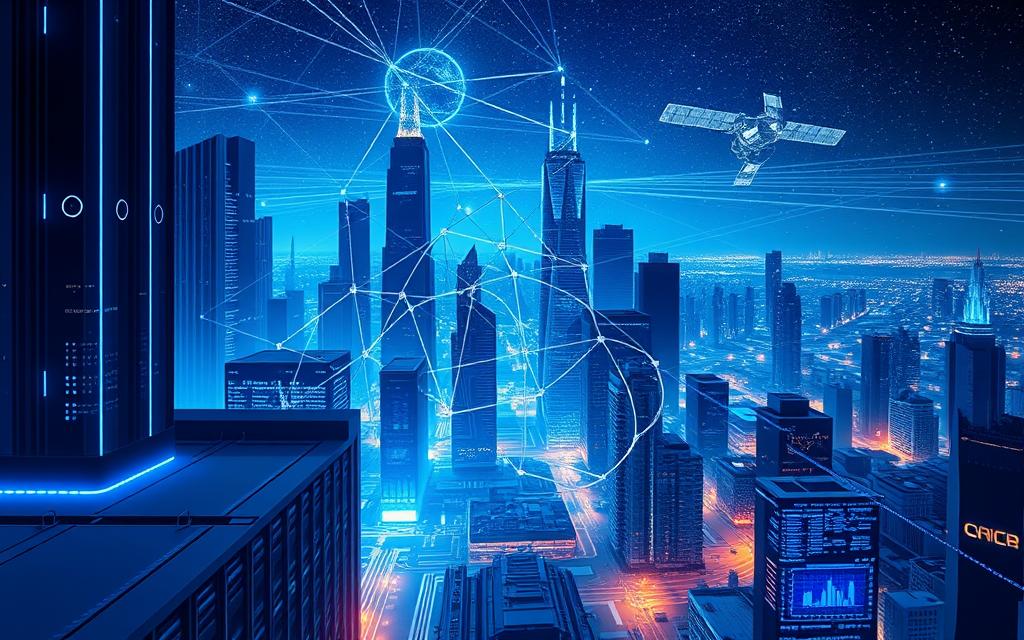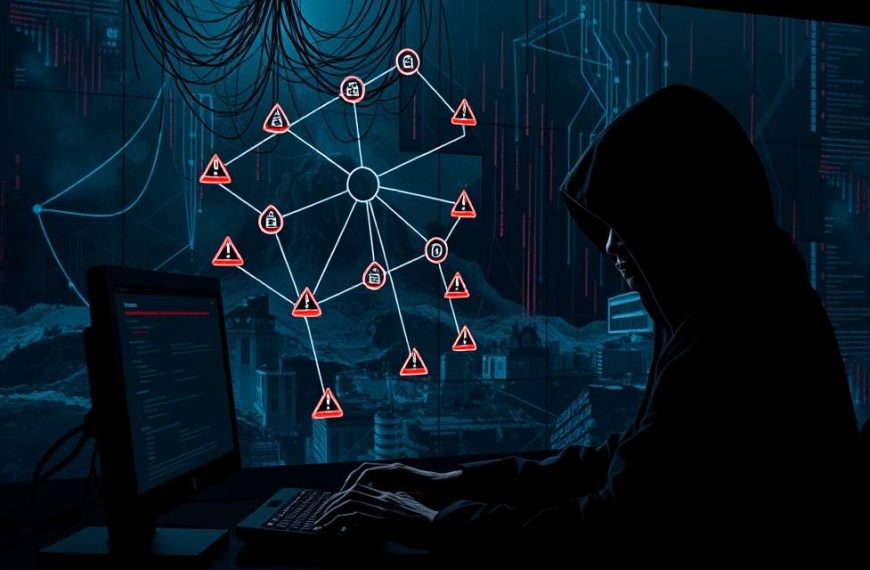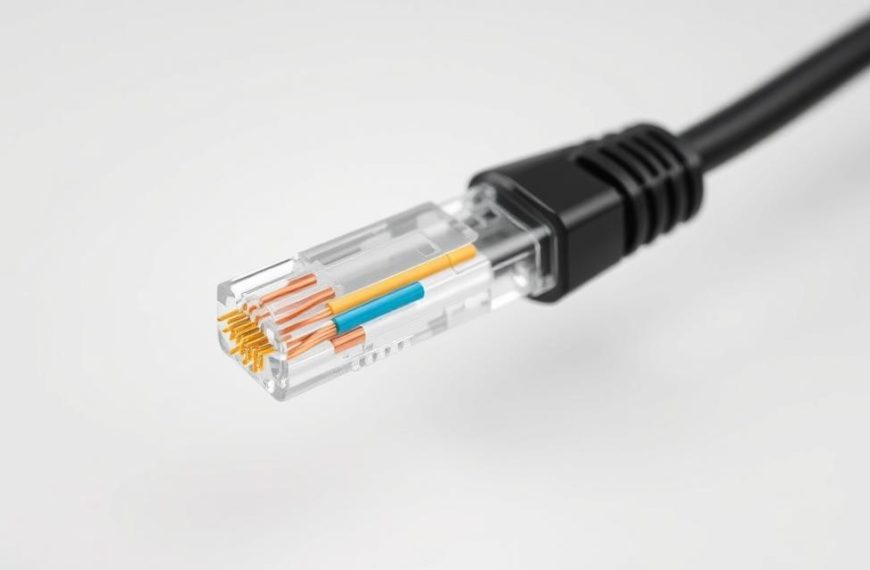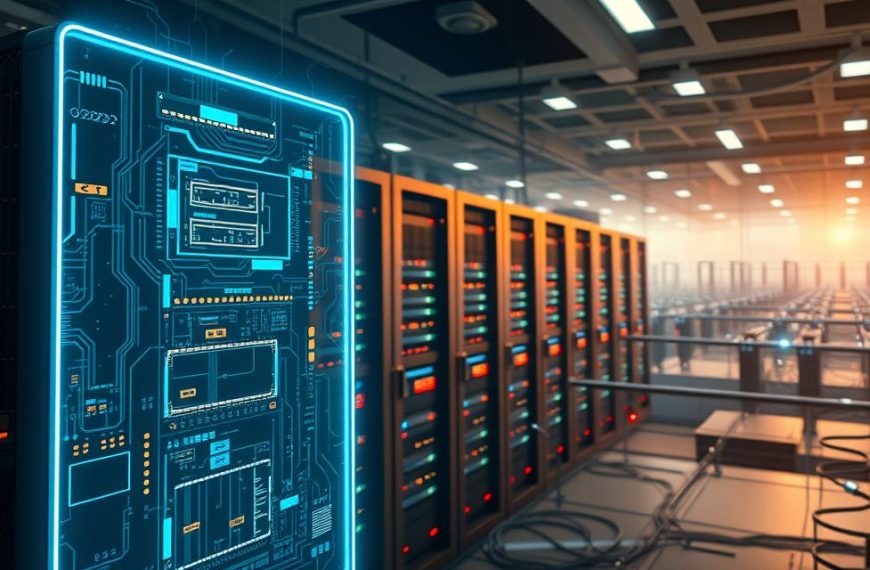In today’s world, strong digital infrastructure is key for smooth work. More than 60% of companies use networked systems for their teams. This lets them work together in real time, thanks to tools like Microsoft Teams.
This change means we need more than just a connection. We need smart systems that are easy to use but also keep data safe.
Cloud tools have changed how we connect at work. VPN use has jumped by 41% in two years to keep data safe. Companies that keep all data in one place see 35% fewer problems.
These networks let teams work together safely from anywhere. This keeps work flowing without a hitch.
Businesses today have to balance flexible work with keeping data safe. They use things like end-to-end encryption and multi-factor authentication. When done right, these tools make work better and more creative.
What Are Computer Networks?
Computer networks are key to digital communication, allowing devices to share and exchange information. They range from small office networks to large global systems. Understanding their parts and designs is vital for improving IT strategies today.
Defining Network Infrastructure
At the core of every network is its infrastructure. This includes physical and logical parts that ensure data flows smoothly. Routers, switches, and servers are essential. Routers manage traffic between networks, switches connect devices locally, and servers store and manage data.
Core Components: Routers, Switches and Servers
Cisco switches use VLANs to manage traffic in big networks. Servers handle tasks like storing files or running applications. This setup shapes network topology, affecting how devices interact.
Physical vs Wireless Architectures
Physical networks use cables for stable connections, perfect for high-bandwidth tasks. Wireless networks, like Wi-Fi 6, offer flexibility but can face interference. Many businesses use a mix of both, with wired connections for servers and wireless for users.
Types of Network Systems
Networks vary in size and purpose. The right choice depends on factors like size, security, and performance needs.
Local Area Networks (LANs) in Office Environments
LANs connect devices in a small area, like an office. They support fast data transfers, essential for tasks like video editing. Most LANs use gigabit Ethernet, meeting Ofcom’s standards for low latency.
Wide Area Networks (WANs) for Global Connectivity
WANs link LANs across cities or countries. Technologies like ISDN protocols helped create modern WANs. Enterprises use WANs to keep data in sync between branches securely.
Cloud Networks and Hybrid Solutions
Hybrid cloud systems mix private servers with public cloud services like AWS. This balance offers cost savings and control. A 2023 study found 68% of US firms use hybrid models to manage IT spending better.
| Network Type | Coverage | Typical Speed | Use Case |
|---|---|---|---|
| LAN | Building/Campus | 1-10 Gbps | Internal file sharing |
| WAN | Global | 10 Mbps-1 Gbps | Multi-site corporations |
| Hybrid Cloud | Flexible | Varies by connection | Data-sensitive industries |
Why Computer Networks Form the Backbone of Digital Societies
Computer networks are key to our modern world. They support everything from big companies to local health services. The pandemic made us even more reliant on them. 73% of businesses said they’d have failed without strong networks during lockdowns, a report by Ofsted in 2022 found.

Revolutionising Commercial Operations
Today, businesses need networks for essential tasks. These tasks help them stay competitive. John Lewis Partnership shows how important networks are.
Real-Time Inventory Management Systems
John Lewis uses a network to keep track of stock across 331 stores and online. This supply chain optimisation saves them £23 million a year from stock issues.
Multi-Site Collaboration Through VPNs
Secure networks let teams in London work with those in Birmingham as if they were in the same room.
“Our VPN infrastructure reduced product development cycles by 40% during hybrid work transitions,”
their Chief Technology Officer says.
Global Communication Infrastructure
Modern networks have changed how we talk to each other. This is seen in:
Enterprise Video Conferencing Solutions
Platforms like Microsoft Teams support 300 million meeting participants daily. They need reliable networks. NHS Digital used this to keep patient consultations going during COVID peaks safely.
Instant Messaging Architectures
Slack handles 1.5 billion messages a week. It shows how networks keep teams working together, no matter where they are.
Data Governance Frameworks
Networks help manage our data today:
Unified Storage Systems
NHS Digital’s network keeps 55 million patient records safe across 21,000 places. This digital transformation cut duplicate tests by 18% in 2023.
Disaster Recovery Protocols
Networks can switch to backup systems quickly. When Manchester University Hospital was hit by ransomware, their network got back to normal in 47 minutes.
Key Network Technologies Driving Connectivity
Today’s digital world is shaped by three key systems. They change how we send data and make our operations better. These systems tackle the need for more bandwidth, better security, and fast data processing across many fields.
5G Mobile Networks
Fifth-generation wireless tech offers 100x faster speeds than 4G. Vodafone’s Manchester factory tests show speeds up to 8Gbps. This brings two big benefits:
Enhanced bandwidth capabilities
Places like stadiums can now handle 1 million devices per square kilometre. For smart factories, it means 500+ IoT sensors can work together without delays.
Low-latency industrial applications
5G’s quick response times under 5ms make real-time robotics control possible. BMW’s Leipzig plant uses it for laser-guided quality checks at 15 metres/second.
Software-Defined Networking
SDN separates control planes from hardware, making service management easier. NHS Digital saw a 73% drop in configuration errors after using it.
Dynamic traffic management
Network admins can now give medical imaging data priority over regular web traffic. This keeps critical systems running smoothly during busy times.
VMware NSX implementations
Studies show big benefits over old setups:
| Metric | VMware NSX | Traditional Networking |
|---|---|---|
| Deployment Time | 3 hours | 3 weeks |
| Annual Maintenance Cost | £18,000 | £52,000 |
| Security Updates | Automated | Manual |
Edge Computing Architectures
Siemens’ Industry 4.0 projects process 89% of factory data locally. This reduces cloud use while keeping response times under 10ms.
Reducing cloud dependency
Processing data on-site cuts bandwidth costs by 40-60% for makers. It also stops production stops during internet failures.
IoT device support
Edge nodes handle 300% more devices than central systems. This is key for smart cities managing traffic and energy grids.
Security Challenges in Networked Environments
As digital infrastructure grows, organisations face more risks from cyberattacks. The UK National Cyber Security Centre (NCSC) saw a 31% rise in ransomware in 2023. This shows the need for strong defence systems.

Cybersecurity Threats Landscape
Ransomware Attack Vectors
Modern ransomware gangs like LockBit use zero trust model gaps. They exploit supply chain weaknesses. The 2023 TalkTalk breach showed how attackers encrypt backups before deploying payloads, affecting 157,000 records.
Phishing Vulnerability Points
Social engineering is behind 74% of breaches, says Verizon’s DBIR. Attackers use fake HR platforms to steal credentials. They hide malicious links in encrypted communications to evade email filters.
“Organisations with Cyber Essentials-certified protections see 80% fewer phishing successes.”
Protection Best Practices
Next-Gen Firewalls from Palo Alto Networks
Cortex XDR uses AI to detect threats in network traffic. It isolates compromised devices in 8 seconds, unlike traditional firewalls.
| Feature | Traditional Firewalls | Cortex XDR |
|---|---|---|
| Threat Response Time | 45 minutes | 8 seconds |
| AI-Powered Analysis | No | Yes |
| Cloud Integration | Limited | Full SD-WAN Support |
Multi-Factor Authentication Systems
Using hardware security keys and biometrics reduces account takeover risks by 99.9%. Microsoft’s 2023 study found MFA cuts credential stuffing attacks by 67%.
Three key steps for network hardening:
- Do weekly vulnerability scans with NCSC-approved tools
- Use zero trust principles to segment networks
- Automate encrypted data transfers
Building Digital Resilience Through Strategic Network Planning
Strong computer networks are key for businesses to stay ahead in today’s world. Companies focusing on future-proofing their networks see big benefits. These include smoother operations and better data protection.
The National Infrastructure Commission says 78% of US businesses will need to upgrade their networks by 2026. This is to keep up with cloud and IoT demands.
Digital resilience is what sets top companies apart. Businesses using Ofcom’s benchmarks see their response times cut by 40%. Regular checks help spot weak spots and open doors to new tech like 5G.
Cisco’s 2024 report shows companies with flexible networks keep 34% more customers. These networks grow fast when needed and stay safe from cyber threats. Working with partners like Palo Alto Networks helps keep important data safe without slowing things down.
Smart businesses see their networks as living systems, not just hardware. They use tools and train staff to use new tech well. As more people work from home, strong networks are essential for keeping work flowing.
Leaders need to make sure their networks are ready for the future. They should check their networks against current standards, look into automation, and focus on security. The digital world rewards those who build flexible foundations for new tech.















